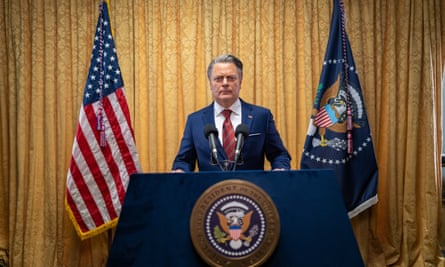As the supreme court heard arguments relating to the 6 January riot and Donald Trump sat in a criminal court in Manhattan, cinemas across America have been showing scenes from an imagined world after the end of democracy. The movie Civil War, written and directed by Alex Garland, depicts a conflict-ridden US in which rebel forces battle to overthrow the government. As a thought experiment, this would be a lot more fun in a year in which a man with 91 felony charges wasn’t standing for his second term as president. As it is, the film currently at No 1 at the US box office is under some pressure to say something meaningful about where we are now.
Civil War does have things to say: about how war is bad, and violence corrupts, and once things get under way people exploit the chaos for all sorts of reasons – which explains the presence of Florida in the film’s imagined secessionist uprising. It’s a gripping ride that, depending on your view, is either shrewdly non-partisan in a way that assumes the audience can fill in the gaps for themselves (the New York Times), an empty but entertaining romp with lots of explosions (the New Yorker) or a provocation to liberals who don’t understand what movies are for (the Hollywood Reporter). Meanwhile, in court this week, prospective jurors in the former president’s hush money trial were warned to keep details of themselves confidential, to preserve against the possibility of juror intimidation – the kind of deep background detail in which the film has no interest.

Instead, we jump to an unspecified near-future in which the US president, a generic strongman played by Nick Offerman, has seized an illegal third term and disbanded the FBI. Two factions across three states have popped up to secede from the US, a coalition between Texas and California fighting under a two-star flag and calling themselves the Western Front, and, separately and with perfect on-brand randomness, Florida, doing its own thing. Much has been made of the political incompatibility of the coalition states, but, it seems to me, this was Garland’s smartest move: California and Texas both have strong regional identities combined with huge resources of land and money that make a coalition against a common enemy feasible.
The problem in this scenario is this: where are the president’s supporters and what are they doing? The movie has no thoughts. There’s no explanation of who the president is, how he got to the White House or what happened to the popular movement that elected him. Instead, the story focuses on a band of plucky photojournalists, led by a brilliant Kirsten Dunst, as they battle to get from New York to the capital to document the fall of DC. In this studiously apolitical setup, we hear references to the “Portland Maoists” and the “Antifa massacre”, while the Western Front is stationed at Charlottesville – a loaded reference evoking the real-life dickheads who marched with tiki torches through that city in 2017 and who, per the film’s implication, eventually managed to upgrade their weapons supplier from Bed Bath & Beyond.

The intention of these scattergun political references, is, I suspect to make a point about the incoherence of war, or rather, the irrelevance of politics to those suffering at the sharp end. That’s not how it lands. The visual imagery is stunning in the manner of Garland’s brilliant 2002 zombie flick, 28 Days Later, in a way that in other years might have carried the film. There is the burnt-out shell of a JCPenney, a downed helicopter on one side in the car park. There is the creepy gas station attendant torturing looters he went to high school with out back. There is the spectacular, minutes-long assault on the West Wing.
And here, in real life, is Trump, charged with falsifying business documents with an intention to violate election laws. Held up against the events that suggested the film in the first place, Civil War has about it a vibe of the guy who doesn’t vote because “they’re all as bad as each other”. The timing matters, and the blandness of the film’s politics, along with its can’t-be-arsed approach to broadening the scope of the story, makes it feel less like a cautionary tale and more like a piece of fantasy unanchored from history. Coming home on Tuesday and turning on the news to hear about Trump nodding off in court, I flashed to the under-imagined world of the film and thought: nah, couldn’t happen here.

